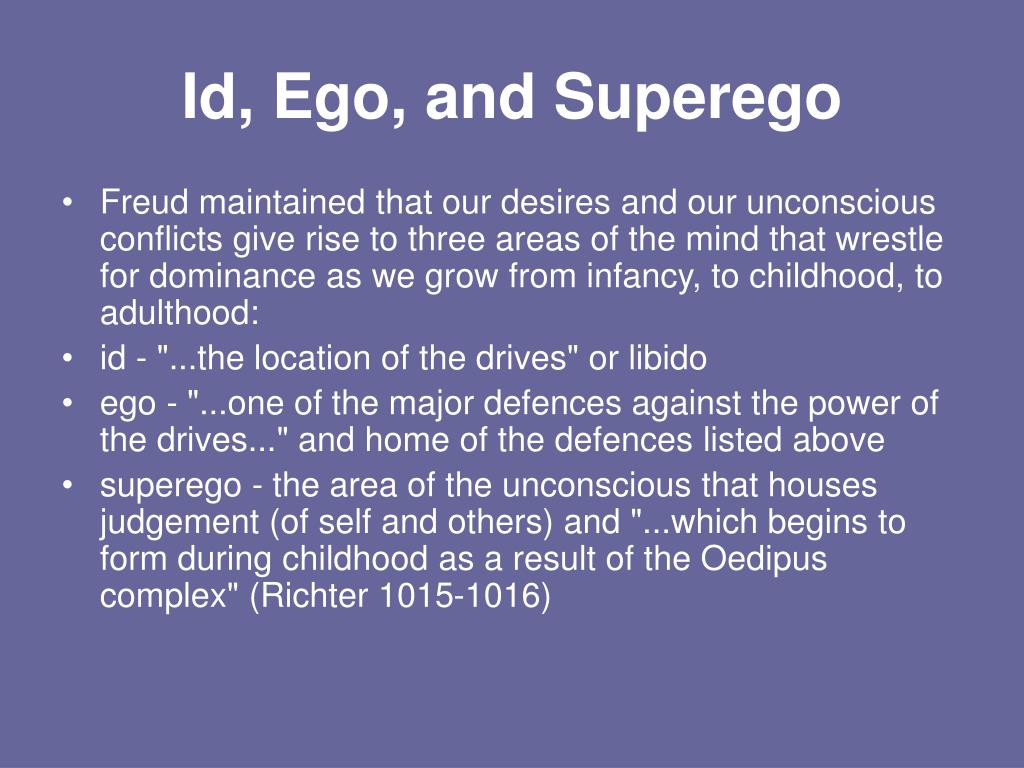

A key point, of course, is that the ego also seeks pleasure. The id demands immediate reduction of tension, in accordance with its pleasure principle, whereas the ego seeks an appropriate reduction of tension, in accordance with its reality principle. This tension arises from internal and external stimuli making demands upon the mind, lowering this tension is felt as pleasurable, and increasing the tension is unpleasant. The ego approaches this task by monitoring the tension that exists within the mind. The goals of these three masters are typically at odds with one another, and so the ego’s task is not an easy one (Freud, 1933/1965). Therefore, it resides partially in the conscious mind, and must serve three tyrannical masters: the id, the external world, and the superego (which we will discuss below).
:max_bytes(150000):strip_icc()/what-is-the-id-2795275_color1-5c05a6dd46e0fb00015fefff.png)
The ego develops in part because it is that portion of the mind impacted by sensory input from the external world. The rider cannot always control the far more powerful horse, so the rider attempts to transform the will of the horse as if it were the rider’s own will (Freud, 1923/1960). Freud likened the ego to a horseback rider on a horse named id. But the id has the energy, the libido, to demand its satisfaction in some way, and the ego can only derive its energy from the id. The id is passionate, whereas the ego represents reason and common sense. Freud believed that the ego is associated with perception (of reality), in the same way that the id is associated with instinct. The ego postpones satisfaction until the time or the circumstances are appropriate, or it may suppress the id impulses altogether (Freud, 1938/1949). In other words, as the id demands satisfaction it is hindered by the reality of our environment, our societal and cultural norms. The ego functions according to the reality principle, and tries to bring the external world to bear on the impulses of the id. The ego arises from the id as an intermediary between the id and the external world. Therefore, we need a secondary process structure in order for the mind to interact with the external world. Actually, we can only know the id through psychoanalysis, since it exists entirely within the unconscious mind. It was during his studies on dream-work that Freud developed his understanding of the primary process of the id (Freud, 1923/1960). Since it can be satisfied in unreal ways, if we examine phenomena such as fantasies and dreams we can uncover the nature of the id. Instead, they can be satisfied through dreams and fantasy.īecause the id demands satisfaction, and knows nothing of restraint, it is said to operate as a primary process. This is a very important point, because it means that the id does not need to satisfy its desires in reality. It is highly mobile and capable of discharge, and the quality of the discharge seems to be disregarded. The energy associated with these impulses, however, is different from other regions of the mind. According to Freud, there is nothing in the id except instinctual cathexes seeking discharge (Freud, 1933/1965).

It knows nothing of value judgments, no good, no evil, and no morality at all. The only goal of the id is to satisfy instinctual needs and desires therefore, it acts according to the pleasure principle. The oldest aspect of the psyche is the id, which includes all that we inherit at birth, including our temperament and our instincts. Freud acknowledged this lack of understanding, and went so far as to say that even if we could localize them within the brain we wouldn’t necessarily be any closer to understanding how they function (Freud, 1938/1949). As with levels of consciousness, it is inappropriate to think of the id, ego, and superego as actual structures within the brain, rather they are constructs to help us understand the psychodynamic functioning of the mind. In addition, these three structures begin as one, the ego develops from the id, and later the superego develops from the ego. It is difficult to discuss the two concepts, levels of consciousness and the psychical apparatus (a term Freud used for the id, ego, and superego), without intertwining them.

In The Ego and the Id (which also discuss the superego, despite not including it in the title Freud, 1923/1960), Freud begins with a chapter on consciousness and what is unconscious, then follows with a chapter on the ego and the id, and then a chapter on the ego and the superego. It is no accident that our discussion of the id, ego, and superego follow immediately after our discussion of the levels of consciousness.


 0 kommentar(er)
0 kommentar(er)
